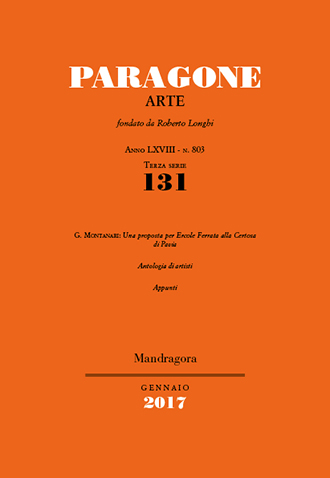Paragone Arte 131

Anno LXVIII – Terza serie – Numero 131 (803) Gennaio 2017
Giacomo Montanari: Una proposta per Ercole Ferrata alla Certosa di Pavia
ANTOLOGIA DI ARTISTI
Lo studio per la pala con la ‘Disputa dei Dottori’: un disegno riscoperto (Claudia Cerasaro)
Una lettera illustrata a Nicolò Simonelli, Guardaroba del cardinale Flavio Chigi (Angiola Canevari e Giulia Fusconi)
APPUNTI
Castel Roncolo dopo Niklaus Vintler. Alcune considerazioni sulla cronologia degli affreschi della Casa d’estate (Marcello Beato)
SUMMARY
GIACOMO MONTANARI
While we know a good deal about the Roman activity of Ercole Ferrata, and his Neapolitan origins have become clearer, almost nothing (other than brief references in Baldinucci’s biography) has emerged about his training with the sculptor Tomaso Orsolino, Lombard by birth but Genoese by adoption. In particular, the project at the Certosa di Pavia, where Orsolino’s workshop was active for about twenty years, remains a key point for clarifying the involvement of the master’s more talented pupils. A stylistic re-reading of Orsolino’s output for the Carthusian monastery thus reveals, distinctly and for the first time – albeit in only a single sculpture – the hand of the young Ercole Ferrata, before his emancipation from a seven-year apprenticeship and his journey to Naples.
CLAUDIA CERASARO
This article was prompted by the rediscovery in a private collection of the preparatory study for the altarpiece of the Disputation of the Doctors of the Church, published in 1970 by Giuseppe Marchini, who attributed it to Girolamo Genga and associated it with the artist’s altarpiece painted for the church of Sant’Agostino in Cesena, now in the Brera Gallery, Milan. An analysis of this sheet, which has been hidden from view since its first publication, provides the opportunity to discuss the relationship between the initial graphic invention and the subsequent, more mature pictorial composition, and thus to study the reasons behind the changes, especially in the conception of space, which are an outcome in the painting of a fruitful dialogue with Fra Bartolomeo.
ANGIOLA CANEVARI E GIULIA FUSCONI
An unpublished and anonymous sheet in the Istituto Centrale per la Grafica, Rome, contains a series of witty vignettes of male and female figures presented as caricatures. These are accompanied by inscriptions and a fragmentary letter addressed to Nicolò Simonelli, the well-known connoisseur and art dealer in seventeenth-century Rome. Contextual study of the letter and drawings has made it possible to identify their author as Francesco Milizia, a painter hitherto known solely for the execution of frescoes and canvases in the Palazzo Chigi at Formello in 1662-1663, when Simonelli was Cardinal Flavio Chigi’s curator. The sheet appears to be linked to a theatrical event at the Cardinal’s court, and casts significant light on a muchpracticed activity in the Chigi milieu.
MARCELLO BEATO
The author presents a general review of the cycles of mural paintings at Castel Roncolo, just north of Bolzano. Bearing in mind new biographical studies on the Vintler family (to whom the commission of these paintings is usually attributed, around 1400) and the recent rediscovery of some late mediaeval secular paintings in Northern Italy, Switzerland and Austria, it is now possible to suggest a new chronology for the extensive figurative programme at Castel Roncolo. The dates proposed here prompt a reconsideration of the exclusive role played by the Vintlers as patrons of this decorative cycle, and pose new questions regarding the reception and spread of the technique of terra verde painting in the Tyrol.
